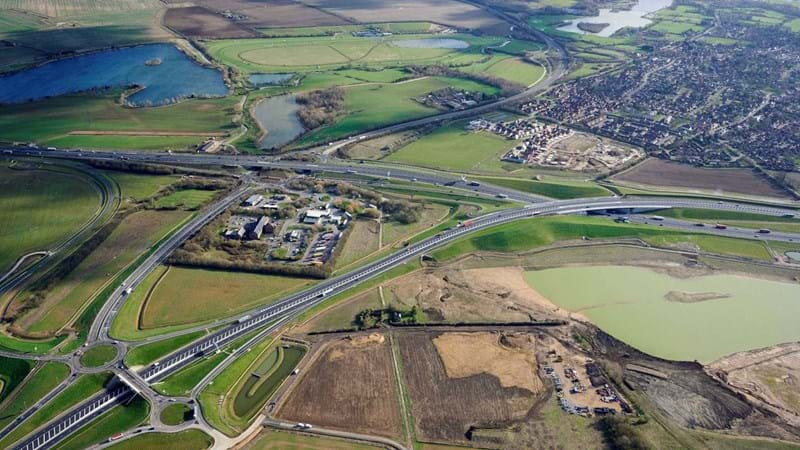Road projects could be delivered faster, thanks to the use of AI
Published
11 May 2021

Share this article
Completing roadworks faster and making sites safer for staff are among the improvements identified using a trailblazing form of artificial intelligence (AI) on Britain’s biggest roads project.
Highways England finished the majority of work on its £1.5 billion upgrade of the A14 in Cambridgeshire, with up to 85,000 drivers benefitting daily following the new 12-mile bypass opening in December and upgrading the rest of the 21-mile stretch to three lanes being completed in May.
Since work started on the A14 in November 2016, the A14 integrated team of companies and contractors working on the project looked to create a uniform way of collecting data, including launching an A14 app which staff could use to record both hazards and good practice. At its peak, some 4,500 observations were submitted in one month.
With such a wealth of information available, from health and safety observations to information about vehicle movements and commercial activity, an advanced AI was used for the first time on a roads project. The £70,000 initiative generated a daily risk profile based on the data it had collected, identifying which days were higher risk and why.
The model was built using these profiles as an indicator for risk, with its findings complemented by the project’s incident register, planned activities, working patterns, job roles, and external factors such as the weather. The development team explored the findings to look into what separated days with ‘harmful features’ from those without them, developing 135 of these ‘features’ which the model could then explore and prioritise, based on their likelihood, including:
• working past 6pm;
• working more than nine hours;
• working in high winds;
• ratio of shift time for archaeologists to that of supervisors
• working following heavy rainfall, and;
• working immediately after a bank holiday or national sporting event.
Looking to identify these high-risk days, the AI was used as a pilot with 75 per cent success – a remarkable result following an initial period of research. An unexpected outcome was the discovery that a workforce engaged in reporting hazards results in less harm. Therefore as the project progressed and incidents of harm were reduced, the accuracy of the model reduced to 65 per cent as there was less data for it to analyse. Despite that, it still proved 160 per cent more accurate than merely guessing which days were likely to have an increased risk.
The AI identified that one of the most prominent themes affecting risk days was staff fatigue, allowing practical measures, such as ensuring breaks are taken, to be implemented to improve safety. The findings of the AI will now be used on other Highways England projects and should make sites safer for road workers, while also improving efficiency.
Highways England’s project director for the A14, David Bray, said:
“Highways England has adopted the A14’s approach and technologies for its own digital platform which is being rolled out across our portfolio. We believe this technology will deliver significant cost savings as paper-based reporting is replaced by real time data, consistently captured and accessible to our project managers”
Mark Tootell, Highways England’s head of the A14’s project management office who led the project, said:
“This exciting research demonstrates three important principles that projects should adopt: the importance of fostering a healthy observation reporting culture across the entire workforce, the value in taking a variety of factors into account and the need for well organised, broad and honest data sets.”
Jaydip Jani, A14 data analyst, added:
“The AI health and safety project showed incredible promise and will only improve as more, better quality data is available. It has shown the industry the intrinsic value in well-gathered data and the potential for truly data-guided decision making.”
The improved 21-mile section is a vital link in the A14 which connects the East coast and the Midlands. The new road, which has been Highways England’s flagship project and the biggest investment in a roads project in a generation, is set to bring nearly £2.5 billion of benefits to the UK economy.
The A14 upgrade has employed over 14,000 people in total, with up to 2,500 working on site during the project’s peak. Building the new road took 14 million construction hours – the equivalent of almost 1,600 years.
Archaeological work on the new road unearthed woolly mammoth tusks and woolly rhino skulls, only the second gold coin of a Roman emperor to be found in the country, and the earliest evidence of beer brewing in Britain, dating back to 400 BC.
The project has also delivered many benefits locally including:
• approximately 24 miles of new routes for cyclists, walkers and horse riders
• a new road for local communities, the A1307, which runs parallel to the new A14 between Cambridge and Godmanchester
• replanting twice as many trees and shrubs as were removed, building over a square mile of new wildlife habitats and creating 24 wildlife tunnels under the road
• funding 55 local community-led projects through a dedicated £450,000 A14 Community Fund
• donating more than £100,000 to local charities since work began in November 2016 including through fundraising as part of the award-winning Great Ouse Challenge race in October 2019.
Highways England will continue to use pioneering digital, data and technology to deliver Britain’s trailblazing roads projects, as laid out in its recently published Digital, data and technology strategy, available here: https://highwaysengland.co.uk/industry/digital-data-and-technology-strategy/
